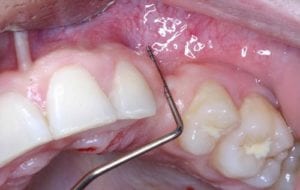When you need to have a tooth or teeth extracted—whether it be due to decay, abscess, gum disease or injury—it is usually in your best interest to do so in a manner that preserves as much of your underlying jawbone as possible. From the time the teeth are removed, significant degeneration of the surrounding bone begins to take place. The amount of shrinkage is unpredictable. Many times the amount of remaining bone shrinks rapidly at first, followed by a more slowly progressing shrinking that occurs over the years afterwards. This shrinking is a natural process, but it is an undesirable result of tooth removal.
You have many options to prevent the rapid initial loss of bone, and it is important that you consider them BEFORE any teeth are removed. Some of these procedures are best performed at the time the tooth is removed. Our doctors specialize in tooth removal, jawbone preservation, and dental implant placement.
 Example of the bone loss that can occur when ridge preservation bone grafting is not performed. Until a ridge augmentation bone grafting procedure is performed a dental implant can not be placed. A dental bridge replacement would appear unnatural due to the indentation in the tissue.
Example of the bone loss that can occur when ridge preservation bone grafting is not performed. Until a ridge augmentation bone grafting procedure is performed a dental implant can not be placed. A dental bridge replacement would appear unnatural due to the indentation in the tissue.
To minimize the rapid shrinking of bone, a bone graft can be placed in the socket at the time of tooth removal. This type of bone graft is straightforward and produces little or no discomfort. A ridge preservation bone graft can often prevent the need for major bone grafting later on. Therefore, a ridge preservation bone graft helps to minimize the need for treatment with major bone grafting in the future.
The slowly progressive shrinking that happens over time is really only prevented by replacing the missing tooth with a dental implant. The pace of this “slow” bone loss is difficult to predict and is influenced by the genetics of the patient.




